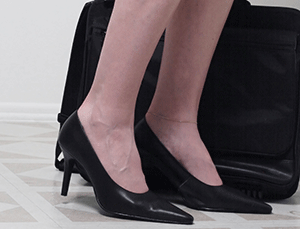 Many women have been chided for wearing high heels, since doctors argue that it can alter the curvature of spine and cause back pain. But recent research shows that this is a common misconception.
Many women have been chided for wearing high heels, since doctors argue that it can alter the curvature of spine and cause back pain. But recent research shows that this is a common misconception.
A study from the Journal of Chiropractic measured lumbar lordosis, or the inward curvature of the spine, in people wearing 3- and 4-inch high heels. Using a Spinal Mouse, the researchers tracked changes in lumbar lordosis as people stood, sat, and walked with heels. They found that wearing heels did not significantly alter the angle or curve of the spine, as previously thought. Their results confirm findings from several recent studies on lumbar lordosis and high heels.
So does that mean women are off the hook when it comes to heels? Not quite, according to another new study. A team of researchers from Poland studied 31 healthy young women between the ages of 22-27 years old. The women were asked to wear 1.5-inch and 4-inch heels while the researchers used electromyographic (EMG) tests to measure muscle activity in the low back, upper thigh, and butt as they relaxed and flexed their muscles. During an EMG test, tiny electrodes are inserted into the muscles to track the electrical activity of muscle cells. Delayed or abnormal muscle activity can often be a sign of musculoskeletal dysfunction.
The researchers found that compared to wearing no footwear, 1.5-inch heels did not significantly alter muscle activity, but 4-inch heels did. When women wore the higher heels, the lumbar erector spinae muscles were activated earlier than normal during flexion, and the gluteus maximus muscles were activated later. The researchers concluded that high heels alter the coordination patterns of trunk and hip extensor muscles.
These studies suggest abnormal muscle activity may be to blame for back pain from high heels rather than decreased lumbar lordosis. The Polish researchers also pointed out that high heels could result in abnormal spine loading patterns.
So, while wearing heels for a night out may not be too risky, routinely sporting 4-inch stilettos just might cause musculoskeletal injuries down the line.
References
Mika A. The influence of high and low heeled shoes on EMG timing characteristics of the lumabr and hip extensor complex during trunk forward flexion and return task. Manual Therapy 2013; [E-pub ahead of print].
Russell, BS, et al. Measurement of lumbar lordosis in static standing posture with and without high-heeled shoes. Journal of Chiropractic 2013; 11(3): 143-153.